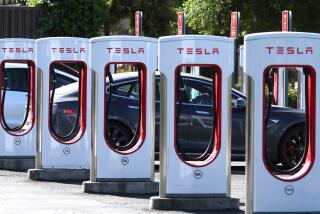ASIA : Singapore in High-Tech Tangle to Fight Automobile Gridlock
- Share via
SINGAPORE — As anyone who has traveled to Asia recently knows only too well, the downside of the region’s economic boom is traffic. Newly enriched middle classes from Jakarta to Bangkok have rushed out and bought cars. Now gridlock--and its collateral woes, such as air pollution--menaces Hong Kong, Taipei, Kuala Lumpur, Manila and even Ho Chi Minh City.
About the only major Asian metropolis that has avoided severe traffic problems is Singapore, a tightly run city-state that has declared war on the automobile, imposing huge taxes that can run $100,000 atop already hefty car prices.
But even these stern measures have not been enough, and the crush has begun to bedevil drivers here too. The number of cars stands at 600,000--one for every five Singaporeans--and continues to grow at 3% a year.
“If Singapore is turned into a huge parking lot and I am still in charge and people are unhappy that they can’t even get out of the parking lot, and say government is no good . . . well, I think it is too late. I can’t solve it at that point in time,” Prime Minister Goh Chok Tong noted recently.
To try to keep the problem under control well into the future, the government is planning a dramatic deployment of high technology. In three years, if all goes according to schedule, the government hopes to begin regulating road use by charging motorists a fee using electronic sensors installed in every car in the country.
“We are using road pricing as a tool to prevent our roads from being congested,” said Maria Choy, a senior planner in Singapore’s Ministry of Communications. “We have a social objective--public transport is more efficient and less damaging to the environment, so society should encourage its use.”
Singapore has experimented with road pricing since 1975. The central business district has been declared a restricted zone, and motorists must buy daily or monthly coupons to pass through one of 33 entry points between 7:30 a.m. and 6:30 p.m. on weekdays. Government statistics indicate that this licensing has been a success: 70% of trips into the district are now done by public transportation.
While it has helped keep that area clear of crushing traffic, the manual system requires a small army of traffic police to enforce. A new electronic road pricing system will initially be aimed at automating the existing system. Instead of a police shack at each entrance to the business district, two gantries will be installed, fitted with antennas. A driver will buy a “smart” credit card from banks or other outlets.
The cards will be inserted into small units--retailing for about $100 and fitted to the windshield in every car. When a driver passes under a gantry, the unit will electronically deduct a predetermined fee and respond in a blink of an eye.
A forerunner of the technology known as Telepass is in use on Italy’s highways. The difference in Italy is that the system is a voluntary way for drivers to pay tolls.
*
In Singapore, virtually overnight the government will require owners to fit 600,000 cars with windshield units. Officials hope to rapidly expand the system from the business district to the nation’s highways. Electronic equipment will be deployed in areas known for heavy traffic and fees charged for using them at rush hour.
“We suppose there will be a hard core of motorists who will be willing to drive at all costs,” Choy said. “They will have that option, but they will have to pay for it.”
Three groups are bidding for the contract to provide the road pricing system, expected to cost $175 million to $210 million when finished. Singapore’s system must be more sophisticated technically than others in use because it will cover several lanes, not just one, say, as is the case in Italy.
The key to the success of the system, Singapore officials say, is offering motorists alternative public transportation wherever road pricing is put into effect. The country boasts one of Asia’s most efficient systems of buses and subways, and the government has announced plans to build a light-rail network to serve remote areas.
More to Read
Sign up for Essential California
The most important California stories and recommendations in your inbox every morning.
You may occasionally receive promotional content from the Los Angeles Times.













